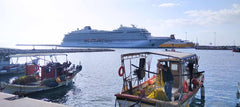Katakolon, Greece

Katakolon Greece
Katakolon is a picturesque fishing village in the area of Ilia in the Peloponnese, Greece.
It is located in the Ionian Sea and has a long history.
Katakolon has a population of about 500 permanent residents.
You can walk all over Katakolon in 20 minutes! It is small and consists of three parallel streets:
The one is a promenade in front of the sea, the second is the main street where mostly shops are gathered and the third in the back is a quaint street and mainly residential area.
Don't miss to walk these streets and see the architecture from old fishers cabins to beautiful neoclassical buildings. Also check this blog article with great "What to do in Katakolon" suggestions.

Today Katakolon is one of the most important cruise ports in Greece, where numerous cruise ships from all over the world dock.
The most charming thing about the area is its tremendous variability:
There is a vast landscape with eternal olive groves and fragrant lemon and orange trees. And, of course, there is the sea, dominating everything with its eternal blue waters combined with the green hill.
Katakolon is known as the birthplace of Ioannis Latsis, the famous tycoon and shipowner, and the port bears since 2018 his name.

The fishing village Katakolon has changed slightly with the modernization of recent years, but it has not lost its character and charm.
If you prefer just to sit there, breathing the sea, experiencing the light, and watching the fishing boats leaving and returning, you can do that today as well as in old times.
Or take a walk to the top of the hill overlooking the sea.
But you can also, if you want, get into nice company in new chic beach bars. And, of course, there is excellent sea food, the freshest you can imagine.
Katakolon is a famous shopping village, check the great variety of shops located in the area, you will be pleasantly surprised. Also keep in mind if you are in a cruise: The general rule of thumb is always do your shopping in the least known place.
Katakolon history
Katakolon is located on a peninsula. So, there were harbors on both sides.
1. Antiquity
The antic port, named PHEIA or PHÄA or PHEA, was located at the northern tip where you can find the village of Agios Andreas today. It is already mentioned by Homer.
Archeaological remains date from 3000 BC.
Thucydides, in "History of the Peloponnesian War" (Book II - chapter 25) - reports that the Athenian fleet arrived at the the other side, in the bigger bay of today’s Katakolon, 431 BC during the Peloponnesian war:
"Touching at Pheia in Elis, they ravaged the country for two days and defeated a picked force of three hundred men that had come from the vale of Elis and the immediate neighborhood to the rescue. But a stiff squall came down upon them, and not liking to face it in a place where there was no harbor, most of them got on board their ships, and doubling Point Ichthys sailed into the port of Pheia" (sic).
They remained there and used the port as a base for military operations.
You can see remains of an ancient city still existing underwater in google maps satellite view here, and also in this video:
2. Middle ages
The castle Pontikokastro was built in the middle ages. It is located on top of the hill of Agios Andreas, the other side of the peninsula, opposite of today’s Katakolon.
From here, you can see the island of Zakynthos in good weather. Swimming, you can also see underwater remains of Pheia. When they were explored, remains of the city were found from the early Helladic period to the Byzantine period. This region frequently suffered from earthquakes and following tsunamis. For Pheia a tsunami is reported to have occurred 551 A.D. Earth quakes and tsunamis also destroyed Olympia.
However exactly it was - Katakolon is one of the very old and and in old writings again and again quoted places. Especially the Greek geographer and historian Strabon (64-23 BC) has evaluated the much older texts.
3. Modern times
In the modern times (middle of 19th century) Corinthian currant was the number one exported product in Greece - it was considered black gold.
Katakolon was an important port for the export since the majority of the Corinthian raisins was produced in the area of western Greece.
Ships sailed loaded with this unique product to Italy for further distribution to the rest of the world.
The majority of the buildings you see in the village today were warehouses for the Corinthian raisins.
The Corinthian raisin export from Katakolon was the reason why the first railroad in Greece was bulid in Katakolon, connecting Katakolon with the city of Pyrgos. This railroad still exists and you can see it when you visit the area.
Katakolon weather
Katakolon has Mediterranean climate:
In general the area has in average 2546 hours of sunshine per year - that's over 200 days a year!
In other words the chances that you see this sky in Katakolon are enormous high:

The temperatures can vary from minimum 7.3(°C) or 45.1(°F) in January (the coldest month) to maximum 31.6 (°C) or 88.9(°F) in August (the hottest month) in average.
The waters are warm and you can still go for a pleasant swim till November or even October!
The Precipitation / Rainfall can vary from 127(mm) in January to 6(mm) in August.

For more information and charts about Katakolon weather check here (reference site).
Katakolon map
(Use two fingers to move the map)



















